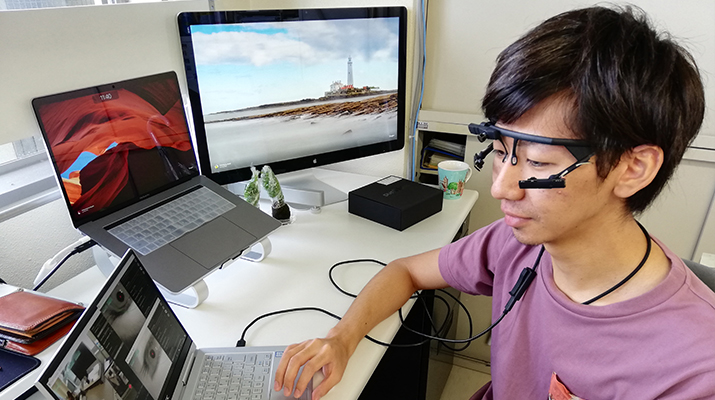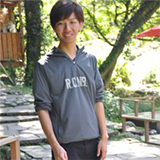
ここからコンテンツです。

Studying Insight
Does pupil dilation occur before insight? By Yuta Suzuki
Yuta Suzuki, a Ph.D student and a member of the Computer Science and Engineering Research Team at Toyohashi University of Technology has measured the human pupil upon gaining insight into an object. It is known that pupils dilate/narrow to adjust the amount of light entering the eye and that emotional state affects the extent of dilation/narrowing. This study indicates that dilation extent varies depending on if inspiration occurs and that dilation occurs before inspiration. The results of the present study were published in Scientific Reports on May 2nd.
The Computer Science and Engineering Research Team at the Toyohashi University of Technology has measured the pupil (referred to as the "black part" of the eye) when a person is inspired by an object. It is known that the pupil dilates and narrows to adjust the amount of light entering the eye, and that the extent of dilation/narrowing varies depending on the emotional state of the person. In the present study, we measured the reaction of the pupil when a person is shown a video made to elicit inspiration (a video in which an object gradually appears). Reactions at the moment of inspiration were compared to reactions when no inspiration occurred, and it was found that the extent of pupil dilation varies depending on whether or not a person is inspired by an object and also that the pupil is already largely dilated at a previous stage. The results of the present study were published in the British scientific journal Scientific Reports on May 2nd.
As indicated by inspiration being referred to as an "aha moment" or a "Eureka moment," people perceive inspiration as a momentary event. However, a previous study reported on changes in a person's brain activity prior to them being inspired during a quiz that asked for a common word based on multiple different words. The present study investigated this further by conducting an experiment under the hypothesis that memory retrieval, which involves inspiration in object understanding, occurs in association with pupil dilation. As a result, it was found that the pupils of the experiment participants had dilated before they reported inspiration, which predicted inspiration thereafter. It is therefore believed that this discovery may lead to externally monitoring and controlling new strategies for memory retrieval in the future.

Lead author of the study and PhD student Yuta Suzuki explains that, "Most of the time, we are not conscious of our brain's activity. Perception and recognition are merely one part of total brain function, and there are many mysteries still left to solve with regard to this unconscious part of our brain that accounts for the majority of its activity. We decided to focus on people's object recognition and were able to use biometry to monitor the processing that occurs before a person is aware they have recognized an object. Even more surprising is the fact that a participant's confidence surrounding object recognition during a recognition task did not come into play. In other words, the pupil reacted regardless of whether the participant subjectively believed they were close to getting the answer, and we only tracked whether or not they answered that they recognized the object. We believe this suggests that successful memory retrieval of an object in subconscious processing is in fact reflected in pupil dilation."
Research team leader and Associate Professor Tetsuto Minami says that, "Up until now, we mainly researched 'inspiration' by measuring brain waves, but we can now expect new developments with combinations of different measuring techniques thanks to this new discovery using non-contact pupil measurement technology."
Associate Professor Tetsuto Minami further states that, "Being inspired by objects is deeply related to memory retrieval success. If we can, for instance, uncover a brain processing mechanism in which pupil dilation and problem solving based on inspiration are related in a different way, this could be used as an index when comparing healthy patients to patients with a cerebral function disorder (for example, patients on the autism spectrum and patients with schizophrenia). Externally controlling pupil dilation is also expected to help with both diagnosis and treatment if it can be used to promote cerebral processing."
The present study was conducted with the assistance of Grants-in-Aid for Scientific Research numbers A(26240043) and B(17H01807) from the Japan Society for the Promotion of Science. The lead writer Suzuki also received a grant as part of the Program for Leading Graduate Schools run by the Japan Society for the Promotion of Science.
Reference
Suzuki, Y., Minami, T., & Nakauchi, S. (2018). Association between pupil dilation and implicit processing prior to object recognition via insight. Scientific Reports, 8(1), 6874.
https://doi.org/10.1038/s41598-018-25207-z
ひらめきを科学する
ひらめきに先立って生じる瞳孔散瞳By 鈴木 雄太
豊橋技術科学大学 情報・知能工学系の研究チームは、ヒトが物体に対するひらめきを生じたときの瞳孔を計測しました。瞳孔は、目に入る光を調節するために、散瞳・縮瞳をする機能を持つ一方で、ヒトの精神状態を反映してその大きさが変化することが知られています。結果として、瞳孔は物体に対してひらめきを生じたかどうかでその散瞳量が変化するだけでなく、その前段階ですでに大きな散瞳を示すといった結果を見出しました。本研究成果はイギリスの科学誌 Scientific Reports に 5月 2日付けで掲載されました。
豊橋技術科学大学 情報・知能工学系の研究チームは、ヒトが物体に対するひらめきが生じたときの瞳孔(眼球にある、いわゆる黒目と呼ばれる部分)を計測しました。瞳孔は、目に入る光を調節するために、散瞳・縮瞳をする機能を持つ一方で、ヒトの精神状態を反映してその大きさが変化することが知られています。本研究では、ヒトがひらめきを生じさせるような動画(徐々にオブジェクトが現れる)を見ているときの瞳孔反応を計測し、物体に対してひらめきを得たときと、得ていないときの反応を比較しました。結果として、瞳孔は物体に対してひらめきを生じたかどうかでその散瞳量が変化するだけでなく、その前段階ですでに大きな散瞳を示すといった結果を見出しました。本研究成果はイギリスの科学誌 Scientific Reports に 5月 2日付けで掲載されました。
ヒトがひらめきを得る場合に主観的には一瞬の出来事のように知覚されます。これによって、ひらめきは例えば、「アハ!体験」や「Eureka moment」のように表現されます。しかしながら、過去の研究では、複数のワードからある共通のワードを想起するようなクイズにおいて、ひらめきまでの事前の脳活動の変化が報告されてきました。本研究では、これを深化させ、物体理解におけるひらめきを伴う記憶検索が瞳孔散瞳に付随して生じるのではないかといった仮説のもとで実験を行いました。結果として、瞳孔は実験参加者がひらめきを報告する前にすでに散瞳しており、その後のひらめきを予測しました。したがって、将来的にこの発見は、記憶検索のための新しい戦略を外部から観測・コントロールすることにつながるかもしれないと研究者らは考えています。
「我々の脳のほとんどは無意識に働いていて、私たちの意識に昇る知覚や認知は一部であるといわれています。このため、脳処理の大部分を占める無意識の世界には未だに多くの謎が残されているといえます。我々はその中でも、ヒトの物体認知に焦点を当て、生体計測によって意識に上る前の処理を観測することに成功しました。さらに驚くべきなのは、参加者が行ったひらめきタスクにおける自信度が関連しなかったことです。つまり、参加者は主観的には、もう少しでひらめきそうだ、のような感覚に瞳孔は関連せず、ひらめきを得たと応答したかどうかのみをトラッキングしていました。これは、無意識な処理における物体に対する記憶検索の成功が確かに瞳孔散瞳に反映されていることを示していると考えています。」と筆頭著者である博士後期課程の鈴木雄太は説明します。
研究チームのリーダーである南哲人准教授は「われわれは、これまで「ひらめき」について主に脳波計測を用いて研究してきましたが、今回、非接触計測技術の瞳孔計測で発見が得られたことから、複数の計測技術の組み合わせによる新たな展開などが期待できます」と説明します。
続けて、南哲人准教授はこう主張します。「物体に対するひらめきは、記憶検索の成功と深い関連があり、例えば、瞳孔散瞳とひらめきに基づいた問題解決との間の関連が異なる脳処理メカニズムを見出すことができれば、健康な参加者と脳機能に問題を抱えている患者(自閉スペクトラム症や統合失調症等)との比較に使用するための指標になりうるのではないかと考えています。また、瞳孔散瞳を外部からコントロールすることによって、そういった脳処理を促進することができれば、病気の診断だけではなく、治療に役立っていくのではないかと期待しています。」
本研究は、文部科学省・日本学術振興会科学研究費基盤研究 A(26240043)、基盤研究B(17H01807)、の助成によって実施されたものです。また、筆頭著者の鈴木は文部科学省・日本学術振興会の実施する博士課程教育リーディングプログラムの支援を受けました。
Researcher Profile

| Name | Yuta Suzuki |
|---|---|
| Affiliation | Department of Computer Science and Engineering |
| Title | PhD student |
| Fields of Research | Computer engineering, Object recognition, Insight, Psychophysics, Pupillometry |
ここでコンテンツ終わりです。
